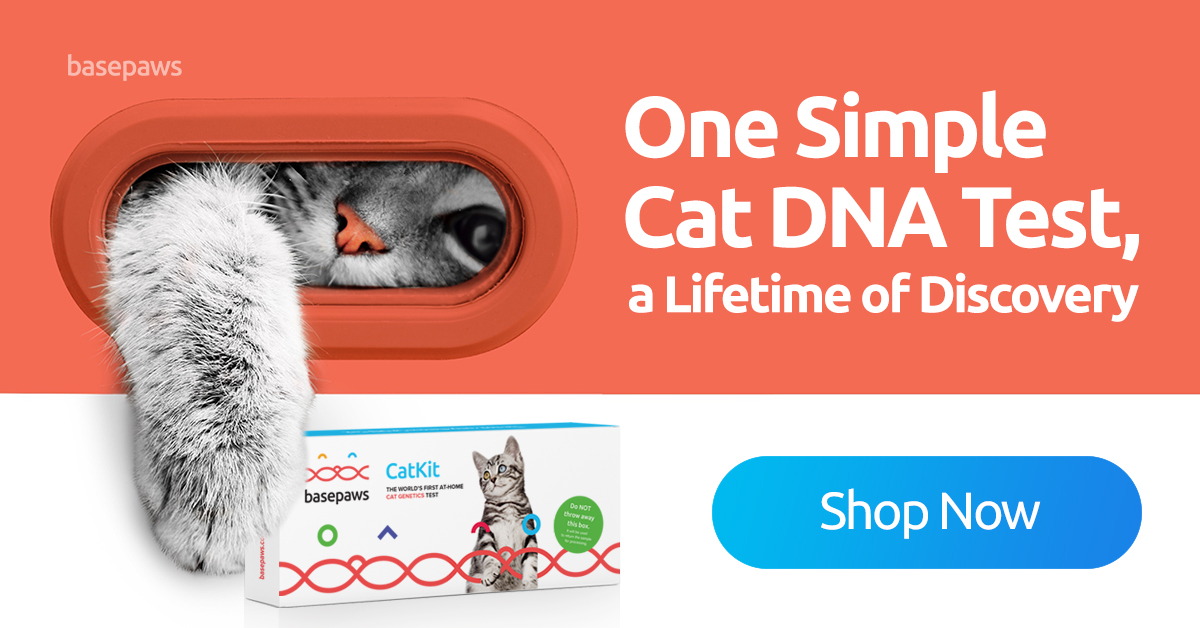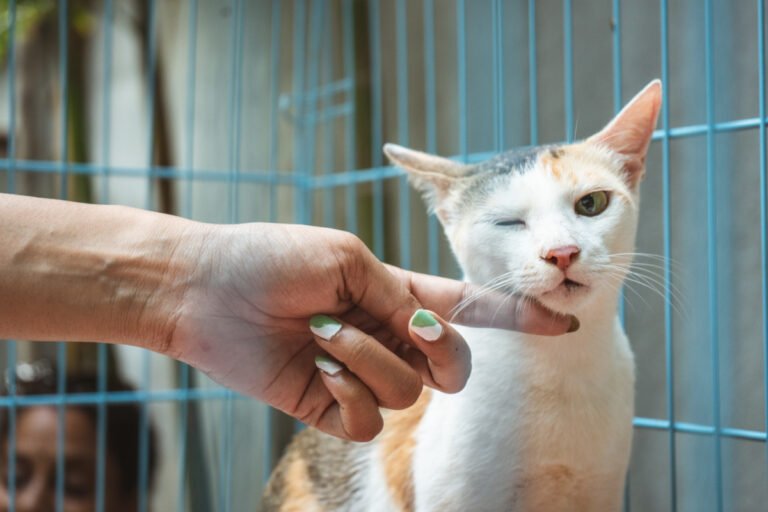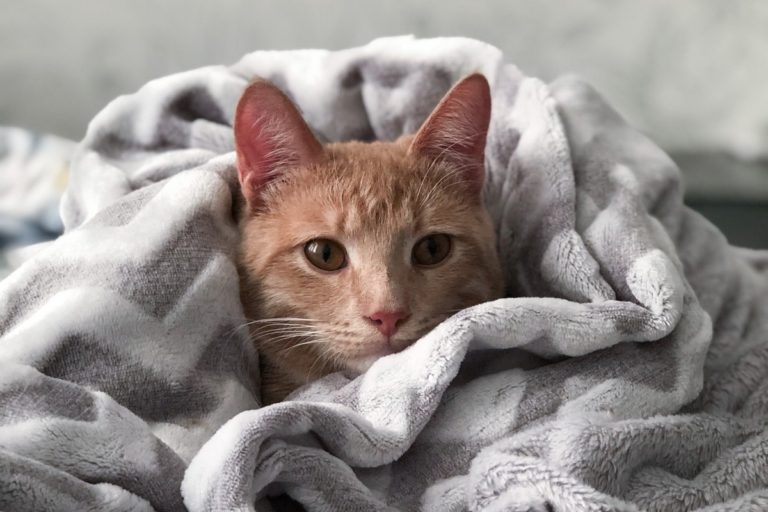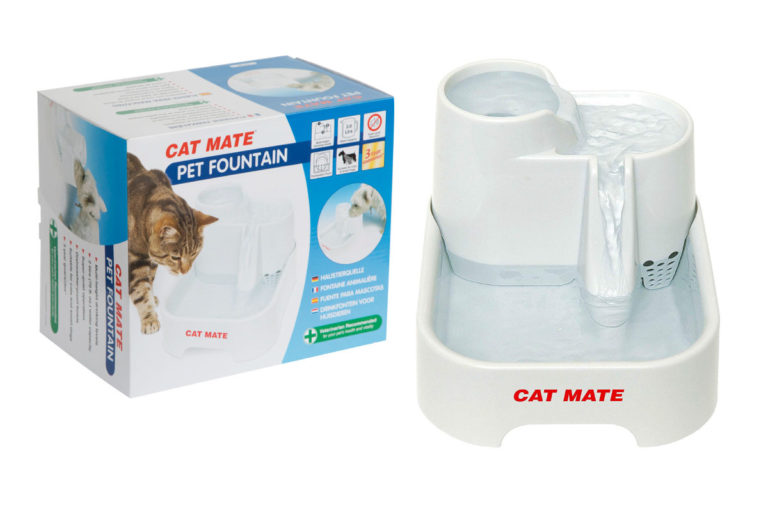When temperatures start to rise and you have a cat that loves to sprawl in the sun, it’s important to know how to recognize when your furry companion is in need of rehydration. Fear not! This handy article will tell you about the 12 most obvious signs of dehydration in cats and how to go about the necessary step of rehydrating them.
DISCLAIMER: This post may contain affiliate links. If you click one of these links and decide to make a purchase, we may receive a small commission. This comes at no extra cost to you and helps to keep the site alive and up to date. If you want more information, please review our Privacy Policy. Thank you for your support!
How Much Water Does A Cat Need Daily?
On average, cats need about 0.8 ounces of water per pound of body weight. Or, if you prefer the metric system, 50 milliliters per kilogram of body weight. So, if your cat weighs 10 pounds, then she needs 8 ounces of water, which amounts to exactly 1 cup.
On warmer days, she will need more. Cats sweat very little; only from their paws. Instead, they lick their coat to keep themselves cool. Not only does this require a lot of spittle, it also means more hairs will enter your cat’s digestive tract. Without the proper amount of fluids those can turn into a hairball ready to clog up her intestines.
Keep in mind that not all of your cat’s water has to come from her drinking bowl or pet fountain. If your cat is on a healthy diet of mostly wet food, then she will get the bulk of her fluids from that. Still, you should always leave out enough fresh, preferably flowing, water, even if you never catch your cat drinking from it. You never know when she may need it.
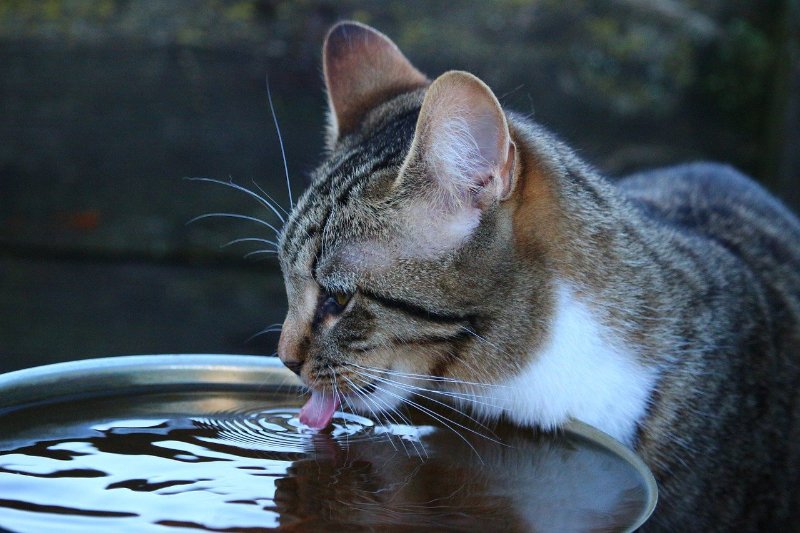
What Causes Dehydration In Cats?
Obviously, lack of access to fresh, clean water is the number one reason why a cat would get dehydrated. But there are more and far less obvious things that can affect your cat’s thirst level and water intake.
Physical Injury
Sometimes, a cat will not drink enough water because she is in pain. This can be due to a wound from an accident or a fight with an adversary. But it can also be an injury caused by an underlying disease or ailment.
For instance, a cat that is suffering from dental issues, like infected gums or a rotting tooth, may have difficulty eating or lapping up the water. Or the coldness of the water may actually hurt their mouth. In these cases, healing the injury will immediately take away the cause of dehydration.
Other injuries can prevent your cat from reaching the water bowl. Older cats tend to be less mobile than young kittens. Arthritis and just plain old age can make it difficult for them to bend their paws and neck to reach down for a drink. Place your senior cat‘s drinking bowl up a bit higher, or look for a pet fountain with different levels to make sure all your kitties can get their fluids.
Acute Illness
There are several causes of acute dehydration in cats. These include:
- Sudden and severe illnesses, such as a urinary tract infections or acute kidney failure.
- Excessive vomiting from an intestinal obstruction caused by hairballs or ingestion of inedible materials.
- Extreme cases of diarrhea due to sickness or allergies.
- Poisoning, which can happen by accident or with malicious intent.
In any case, if you find your cat suddenly parched and drinking water like there’s no tomorrow, it is time to spring into action! Take them to the vet right away to find and eliminate the cause of their dehydration, and then work to get them back on their feet.
Related Post: Is Pet Insurance Worth It For Indoor Cats?
Is pet insurance worth it for indoor cats? Read this guide to learn about pet insurance for cats and calculate if it is really worth it for your indoor cat.Chronic Illness
Chronic diseases that affect your cat’s kidneys or digestive system are also likely to cause dehydration. For instance, hyperglycemia (high blood sugar) can trigger dehydration, which automatically puts diabetic cats at a greater risk.
Allergies fall in both the acute and chronic category. A severe allergic reaction can be triggered by the first exposure to an allergen, in which case the onset of symptoms is considered acute. In other cases, the exposure occurs over a longer period of time during which the allergic reaction slowly gets more severe.
Hyperthyroidism is an example of a digestive disorder that directly affects your cat’s metabolism by speeding it up. This can cause nausea and chronic diarrhea, which in turn can lead to dehydration.
The sad part about dehydration paired with chronic disease is that you can’t take away the cause. Instead, it is all about monitoring your cat’s water intake and urination patterns as best as you can. If you notice any changes that you think might be related to your cat’s illness, consult with your vet on what steps to follow.
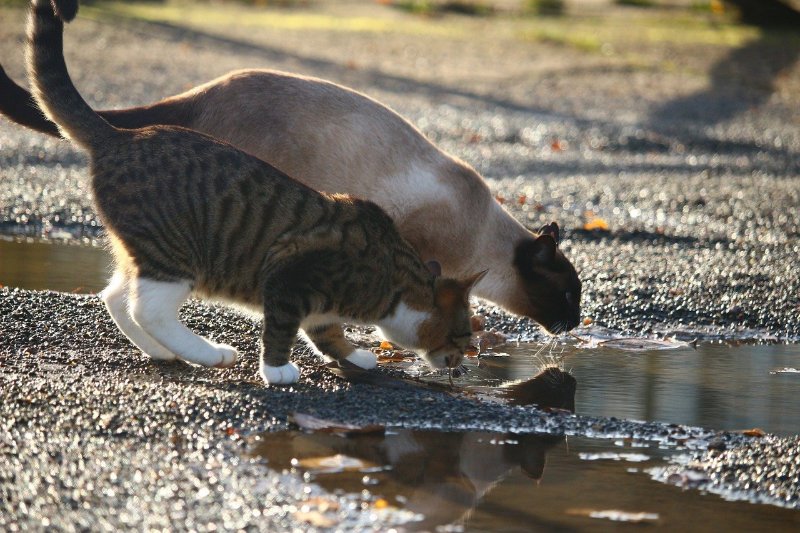
Dehydration In Cats With Kidney Disease
Kidney disease is a chronic, irreversible condition that severely impacts a cat’s internal water management and deserves to take a separate look at.
The kidneys are an important part of the body and if they are not working well, it can lead to a cat being more dehydrated. Cats with kidney disease have an increased risk of becoming dehydrated because their kidneys cannot filter the blood as efficiently as healthy cats. This means that there is protein in the urine which draws water from other areas of the body like muscle, skin and fat.
Water also gets drawn from the intestines. The intestines need this water to stay healthy, and without it the intestinal lining can get irritated. This irritation leads to hairballs forming around food that hasn’t been excreted from the body yet, which then cannot be eliminated.
The hairballs will continue getting larger until your cat is badly constipated (partially blocked) or even obstipated (fully blocked). So you can see why it is extra important to keep your CKD kitty hydrated.
If your cat does get constipated, it is not an immediate cause for panic. There is a wide variety of laxatives and hairball solutions for cats that you can use to clear a blockage and prevent future ones from forming.
signs of dehydration in cats
At this point, you might be asking: how do I know if my cat is dehydrated? Similar to the causes of dehydration, the signs can also be divided into acute and chronic symptoms.
Acute Signs Of Dehydration
- Decreased urination
- Dry mouth and gums
- Lip smacking
- Elevated heart rate
- Panting
- Lethargy
Chronic Signs Of Dehydration
- Constipation
- Sunken eyes
- Poor skin elasticity
- Poor capillary refill
- Urinary tract infections
- Kidney problems
Cat Dehydration Test
Cats are quite good at hiding signs of dehydration. If you suspect your cat might be dehydrated, there’s a quick cat dehydration test that can provide some insight.
Gently pinch the skin on the back of your cat’s neck with your fingers. Pull it up into sort of a tent shape and then let it go. If your cat is well-hydrated the stretchy skin should snap back just like that.
If it takes a second to fall back in place, or stays up for even longer, it’s a clear sign that your cat is lacking fluids. Do your best to rehydrate them and then redo the test.
How To Hydrate A Thirsty Cat
If your cat is showing signs of dehydration, it is important that you step in and help them rehydrate. Don’t expect the problem to just go away on its own, or you will be risking your cat’s life. A cat can’t go without water for very long before succumbing to it.
Running Tap
The quickest way to rehydrate a thirsty cat is to get them to drink from the sink. Fresh, running water has more nutrients and oxygen than a bowl of still water, so it will automatically be more appealing to your cat. The prerequisite, though, is that she still has enough energy to drink on her own.
Use A Syringe
If your cat is too fatigued from dehydration, or just refuses to drink from the sink, you can try giving her water through a syringe. Simply place the nozzle of the syringe in between her teeth, preferably from the side and nearer to the back of her mouth. Don’t stick it in too far, or she won’t tolerate it. Then squeeze out small amounts of water for her to drink.
Go To The Vet
More severe cases of dehydration, or chronic dehydration due to kidney failure or digestive disorders, will require a vet’s attention. Your vet can give your cat a large amount of fluids all at once by injecting them into the abdominal cavity. This will create a big, soft lump on your cat’s side. Over the course of a few hours the water gets absorbed by the body and the lump disappears. It is not a very invasive procedure, though the injection process does take some time during which your cat will have to stay at the vet’s clinic.
A Final Word
Hydration is very important for a cat’s well-being. Now that you’re aware of the signs of dehydration in cats, always make sure your cats have access to enough fresh water. If you’re away from home a lot, or your cats are reluctant to drink from a bowl, try an automated pet fountain. Running water tends to be more appealing to cats and it stays fresh longer than a simple drinking bowl.
Also keep in mind that your cat needs additional fluids on hot days, when they exercise heavily, or when they are nursing kittens, and/or are pregnant females. Do the cat dehydration test if you think they aren’t getting enough water.
If you have questions or concerns about your cat’s drinking habits or see any of the signs of dehydration in your cat, always contact your veterinarian. Even if you think the problem might not be that severe. The fact is, cats have a real tendency to hide their ailments. So by the time you start noticing something, it may have already progressed further than you think. Your vet will gladly help you figure out what’s wrong and how to deal with it.




